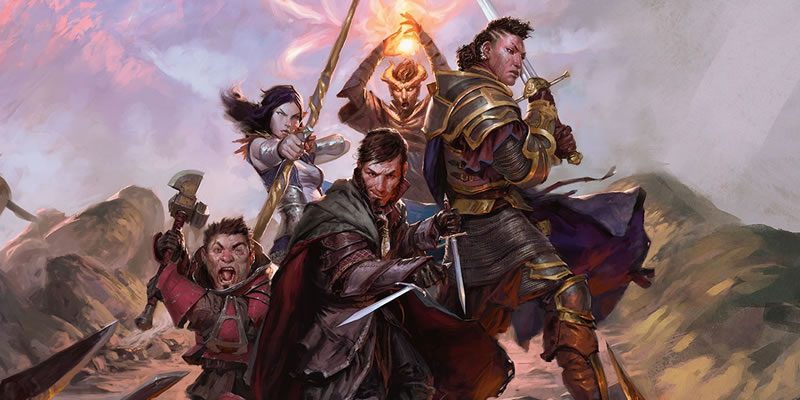Five Tips for New Dungeon Masters

You’ve taken on the responsibility of Dungeon Master for your Dungeons & Dragons group.
What pushed you over the edge? Curiosity about the game? Broken scheduling promises from other DMs? A love of fireball throwing, button pushing, murder-hobos?
Even if you have a lot of experience playing tabletop roleplaying games (TTRPGs) like Dungeons & Dragons, stepping behind the screen can be a whole new world. You might feel a bit intimidated or overwhelmed. That’s okay. That just means you care, which is the most important step toward being a good Dungeon Master.
But you didn’t click on this article for a cyber pat on the back! You want practical advice. So here are five tips for new Dungeon Master:
Know the Rules

One of the DM’s responsibilities (arguably their most important responsibility) is to make sure the inherent truths of the game world remain consistent. The story or setting in a TTRPG can be anything from hyper-realistic to completely zany, but, ultimately, it’s still a game. Games require rules as a framework for everyone to play together successfully. The DM is the appointed expert and final authority on the rules.
This does NOT mean to be a “good” DM you need to read the 636 combined pages of the Player’s Handbook and Dungeon Master’s Guide. Very few DMs read those books cover to cover. But it is important to be familiar with the basic rules. This not only helps you feel confident in your role since you’re able to answer player questions, it keeps the game running smoothly.
How do skill checks work? What is “advantage” and “disadvantage”? What can be done by each player during a round of combat? What is a proficiency bonus and when is it used? What modifier is used for melee vs finesse vs ranged weapons? How the heck do spell slots work? How many spells can be cast in a single turn? What happens when a player character drops to 0 hit points?
Will you remember those rules with 100% accuracy? Unlikely. Will other questions inevitably come up during the course of play? Absolutely. But that’s okay. As long as you have a basic understanding (and keep the rulebooks handy), you will have a strong foundation on which to begin.
You also have the power to bend or change the rules to enhance the story. This is sometimes referred to as the “Rule of Cool”. I would advise new DMs to use the “Rule of Cool” cautiously. It’s important to understand why a rule exists before you break it. On the surface, it seems awesome to allow a character to polymorph into a bug, fly into the enemy’s nose, and then revert to their true form to make the enemy’s head explode. However, now the players will definitely replicate that with every enemy, which will completely throw off the game’s difficulty balance. You probably don’t want every NPC to wear nose plugs and the PCs definitely don’t want you to pull the same trick against them. So treat the “Rule of Cool” like salt: use it sparingly to add flavor until you know which dishes will be inedible with too much.
Remember, YOU are the final authority on rules. If an argument begins to slow down the game, don’t be afraid to make a ruling. Tell the players, “After the session I will find that specific rule or we can talk more about it if we need to, but in order to keep things moving and keep this fun, we will do this for now.”
Have a Session 0

Photo by Dylan Gillis on Unsplash
While doing internet searches on D&D, you’ve probably seen the term “Session 0”. A Session 0 is when the players and the DM meet together before they officially start playing the game. In its most basic form, it’s a chance for the players and the DM to agree upon what kind of game they are going to play and set expectations going forward. Oftentimes during a Session 0, the players will create their characters and the group will play through a short combat scenario to introduce the rules.
This may seem like a waste of time, but it’s actually a crucial component for a successful game. One of the wonderful things about roleplaying games is how flexible they can be. The downside of this is that every person may have a different idea of how the game should be played. If player A expects My Little Pony, player B expects Skyrim, and player C expects Game of Thrones…. You can see how this might be a problem. You need to make sure everyone knows what to expect. This includes talking about the game’s setting (“no machine gun wielding cyborgs in this high fantasy”), the amount of realism employed (“sure, you can carry 5 greatswords, 8000 gold pieces, and heavy plate armor without a penalty”), leveling up expectations (“we’ll use milestones instead of XP”), and parameters for character actions (“you are not allowed to steal from or attack other PCs”).
Another important thing to discuss is the out of game expectations. This frequently gets forgotten or left unsaid, which then causes a lot of friction later. How often is the group going to meet? Will there be snacks, and, if so, who’s bringing them? Is food allowed at the table? Is alcohol? Is this a casual hangout where we may roll dice or will we be focused only on the game? Are non-game related conversations allowed at the table? Are phones allowed at the table? What do we do if someone can’t make it to a session?
Use the Session 0 to get everyone on the same page and excited for the game.
Rails Can Be Okay

Photo by Mike Enerio on Unsplash
There are two broad categories to describe how a DM runs a game. The first is often referred to as a “sandbox” or an “open” world. In a sandbox world, the players can literally do anything they want and the DM will improvise the story based on their actions. The second category is known as a “railroad”. In a railroad world, it doesn’t matter what the players want or try to do, the story is going to happen exactly how the DM dictates.
Hopefully, you can see why railroading has such a bad reputation. It goes completely against the cooperative storytelling that is supposed to happen in TTRPGs. However, this may cause some DMs, especially inexperienced ones, to fall into what I call the “sand trap”. In their fear to avoid railroading, they and their players are left staring at a vast, empty desert where no one knows where to go or what to do. It takes a tremendous amount of work to run a purely sandbox world. You either have to create a vast, detailed playground or be so comfortable improvising that you create it as the session goes. Even the most experienced DMs find running a truly sandbox world extremely difficult.
So how do DMs accomplish it? The secret is: most don’t. Instead, you provide enough options to give the illusion of a totally open world when in actuality the players are selecting between rails number one, two, or three. Then, you create enough of a framework for the world and the motivations driving the NPCs that when the players inevitably choose option D (because “four” would be too easy), you can comfortably re-work one of your plans to match. What causes such strong, negative reactions from players is when they feel like their choices are pointless. However, most players, especially new players, need clear choices to make.
What does that look like practically? Whether you are using a published adventure or one you created, let the player’s know the intended direction of the story. This could be as straightforward as an NPC asking them to perform a quest or as subtle as the PCs spotting a shadowy figure following them. It’s completely okay to nudge the players in a certain direction. Just don’t drag them there against their will.
Be Ridiculous

Photo by Austin Pacheco on Unsplash
Roleplaying is ridiculous. It’s a bunch of people pretending to be magic wielding gnomes, raging barbarian goliaths, and fast-talking elf bards who travel around an imaginary world slaying monsters and saving the day. It’s silly. And that’s what makes it wonderful. It’s a chance to escape the daily grind of life, to foster our imagination and creativity, and to live out our childhood fantasies.
Embrace it. We have been so trained to not be “childish” that most people feel too awkward to relax and just roleplay. As the DM, you have the power to give them “permission” to be ridiculous. Give that goblin an awful Cockney accent. Who cares if you’re terrible – it’s not actually “Cockney”, it’s a goblin accent! Respond in character to the players when they ask an NPC a question. Snarl and howl as that wolf attacks. Stand up and act out the multiattack of that orc. The more animated you are, the more comfortable your players will feel.
If that sounds exhausting, you’re right. It is. But it’s worth it. I guarantee the players will respond to your energy. Start small. You don’t have to be an Academy Award winning actor to be a great DM. Every DM has their own style. The point is to not be afraid to make a fool of yourself so that your players are brave enough to step out of their comfort zones.
Take Notes

Photo by David Travis on Unsplash
Depending on your group’s schedule, it could be weeks or months between sessions. There is no way you or your players will be able to remember everything that happened. So jot down notes during and immediately after the game. It doesn’t have to be extensive unless you want it to be. A sentence or two to summarize what happened during the session will suffice. Some groups have a designated player who does this while others rely on the DM. Who has that responsibility can be another question you bring up during the Session 0.
Beyond just remembering the broad strokes of what happened, the DM should also write down the little things too. Use them to enrich the story. Maybe the child the druid gave a flower to is actually a fey in disguise? Maybe that ring the rogue pickpocketed is cursed or a family heirloom of a powerful mage? Maybe that barfight the monk got into won them the respect of the local gang? Players will think you’re a genius if you find ways to weave even their supposedly “unimportant” actions into the fabric of the story.
DMs should also take note of how much ‘screen time’ each player received during a session. It’s okay for there to be sessions where one character really shines in comparison to the others. However, if there is consistently a character who never gets a chance to stand out, you should intentionally create opportunities for them. Maybe you had a really roleplay heavy session where the gruff barbarian’s player nearly fell asleep from boredom. Next session, make sure there’s a fun combat encounter. Maybe a player has a high Charisma score but is shy in real life, so other players talk over them. Next session, have NPCs direct their questions specifically to that high Charisma character.
Taking good notes can be a simple way to elevate your game to the next level.
This is by no means an exhaustive list. Use this as a starting point from which to grow. The best DMs are those who care enough about their players and the game to continually improve. By taking the time to read this article, you’ve already shown you’re up to the task. Good luck! And welcome to the family, Dungeon Master!



